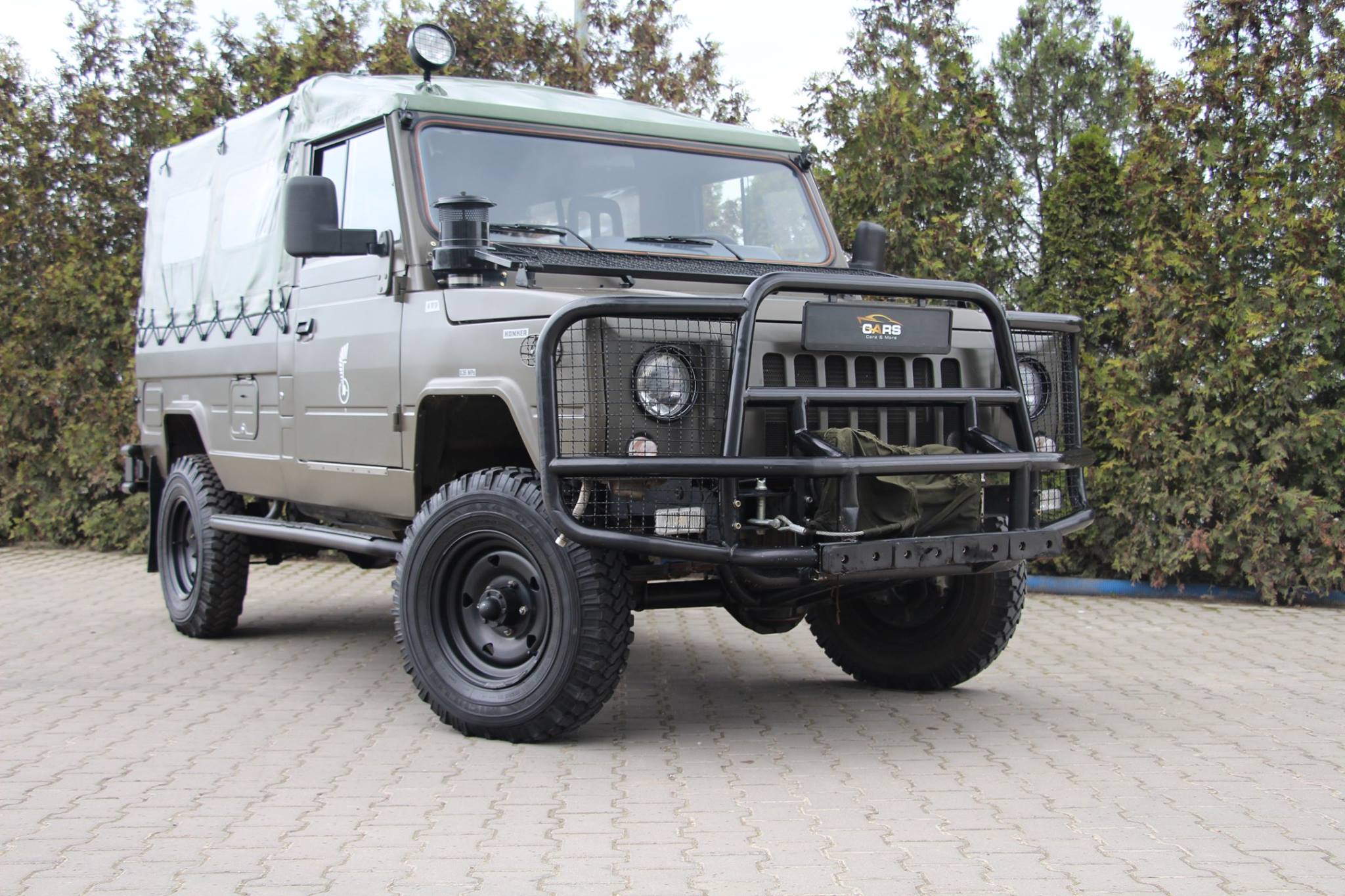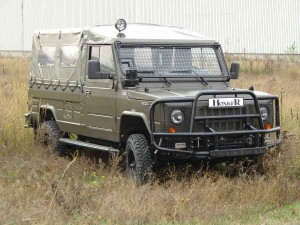Honker 2000, production year 2004, the so-called patrol version. Purchased practically straight from the factory in 2010r - with a mileage of less than 11000km.
At the time of purchase it was practically "brand new" . It was a demonstration vehicle , exhibited at trade shows , shown in brochures .
The Honker is currently styled as a car from the KFOR contingent.
The vehicle appeared in the program Legends of the People's Republic of Poland (episode 8, season 15)
Photo from Intrall Company catalog
OPTIONAL EQUIPMENT:
- Cyclone filter on the windshield - is designed to separate sand in the air sucked in by the engine, such as when driving in desert conditions.
- Additional engine heater - Webasto Hydronic.A digital timer allows you to program the times of activation of the water heater when the engine is stopped.
- Eberspächer Airtronic D2 air heater - which works independently of the vehicle's engine and heating system. This device draws in cool air from inside the vehicle, heats it and blows it back in.
- NOTEK lamp system - there is an additional switch in the cabin, which can be used to set three variants of light darkening. The front headlights have the option of installing guards to reduce light scattering.
- Basket with a 20-liter canister for additional fuel supply.
- Ramsey REP8000 winch with a towing capacity of 3,600 kg.
- Hella Marine searchlight mounted on the roof on the right side, which is controlled from inside the car.
- Windshield protection grilles, lamp protection grilles, extended front piping - same as the Scorpion3 version
- Factory green tarp upholstery
- Unusual, widened rear benches that, when opened, provide convenient access to the contents of the caissons.
GALLERY:
Detailed description of the vehicle prepared by Robert Kupczynski:
CONSTRUCTION
The 2000 Honker is equipped with an Andoria 4CTi90 four-cylinder compression-ignition engine with a displacement of 2,417 cc and 102 hp. The maximum torque is 230 Nm. The engine has a supercharged air cooler and meets EURO 3 emission standards.Drive is transmitted through a five-speed transmission. The transmission is connected via a short gimbal shaft to a reducer. The reducer has two ratios - on-road and off-road - and a lockable central differential. From the reducer, drive is transmitted via shafts to the hypoid bridges. The rear bridge has a differential lock engaged by an electric actuator. The lock can be activated only if the central differential is blocked in the reducer. The indicator lights on the instrument cluster show that the differential in the reducer is blocked, as well as the rear axle lock. The vehicle has permanent four-wheel drive without the possibility of disconnecting the front axle. The whole is complemented by 16-inch wheels with 7.50 Michelin 4×4 tires. The car has an effective braking system with ventilated discs on the front axle and drum brakes on the rear axle. The high ground clearance, high air vents on the bridges, reducer and gearbox, as well as the air intake located on the front hood give the vehicle very good off-road capabilities - in this case wading depth exceeds the factory 800mm.
The Honker's design is based on a simple frame. The suspension consists of semi-elliptical springs and telescopic shock absorbers. The rear axle has a tilt stabilizer, and the front axle additionally has a steering torsional vibration damper. A worm gear with hydraulic power steering is installed in the steering system. In the front part of the frame there are two places where you can hook up a rope and pull the car out of trouble, at the rear there is a jawed military hitch for pulling a trailer. The front of the vehicle is covered by a powerful tubular bumper, in which the winch is mounted, as well as nets covering the lights. The rear bumper is fitted with combination lamps, protected by covers. Additional equipment also includes thresholds that make it easier to enter the vehicle, and are also helpful in lifting it. The windshield is equipped with an additional frame to protect it from damage, such as during riots or preventive operations.
BODYWORK
The body of this Honker is covered with a sheet stretched over a metal frame. Under the sheet a special insulator is attached for winter. The sheet consists of three parts - the first over the driver's compartment, the second over the passenger compartment, and the third serves as a bulkhead wall between these compartments. There is also a lower metal bulkhead wall between the compartments, to which an axe, shovel and pickaxe are attached from the driver and passenger seats with handles. There are also gun mounts in the cabin. The windshield frame is mounted on hinges and can be folded down after proper preparation, the door glass frames and the glass in the rear door have the possibility of quick removal. The folding top of the body allows air transport and landing drop of the vehicle.
EQUIPMENT
There is a cyclone filter on the under-panel to separate sand in the air drawn in by the engine, such as when driving in desert conditions. The vehicle was equipped at the factory with an additional engine heater - a Webasto Hydronic. Of course, an indispensable (for a military vehicle) equipment is the NOTEK lamp system - there is an additional switch in the cabin, with which you can set three variants of darkening of the lights. The front headlights have the option of installing guards to limit light scattering. The hood is supported by telescopic shock absorbers, in addition, there is also mounted in the engine compartment a quick-charging socket for the battery, which can be used to start the engine from another car equipped with a similar socket.Behind the front doors on both sides of the vehicle are the filler ports for two independent fuel tanks, each with a capacity of 55 liters. The switch for the tanks is located in the floor next to the gearshift lever, and there is an additional key on the dashboard that toggles the fuel level indicators in the tanks so that they indicate the correct tank when switched. This solution is intended to enable the vehicle to operate, for example, after one of the tanks has been punctured. At the rear of the vehicle, next to the spare wheel on the right side, there is a basket with a 20-liter canister for an additional supply of fuel.A Ramsey electric winch with a 3,600 kg towing capacity is mounted in the front bumper from the factory. Front and rear fog lights are also fitted as standard. In addition, an Eberspächer Airtronic D2 air heater - which operates independently of the engine and the vehicle's heating system - is installed in the passenger compartment. This device draws in cool air from inside the vehicle, heats it up and blows it back in. A digital timer allows you to program the times when the water heater is turned on while parked with the engine off. A searchlight is mounted on the roof on the right side, which is controlled from inside the car.
INTERIOR
There are two seats in the front of the vehicle and four double benches in the rear. Under the benches, which open upwards, there are roomy storage compartments for necessary tools, such as a jack, etc. The seats and benches are covered with tarpaulin upholstery. Between the front seats there are two reducer levers - the right one changing the ratio :road-terrain and the left one - blocking the central differential. The vehicle has two heaters - one standard one used for heating the driver's cabin and the other for heating the passenger compartment. The Honker also has a switch to close off the supply of outside air and an additional switch to close off the supply of hot water to the heater. A lockable storage compartment is mounted on the dashboard, as well as an instrument panel, the same as in the Polonez Atu Plus. In addition, there are pad wear sensors mounted in the front brake pads and the car was equipped with a system that informs of a burned-out bulb in the exterior lighting . This was not present in previous copies of Honkers.





































































no comments on Honker 2000 (patrol) - Robert